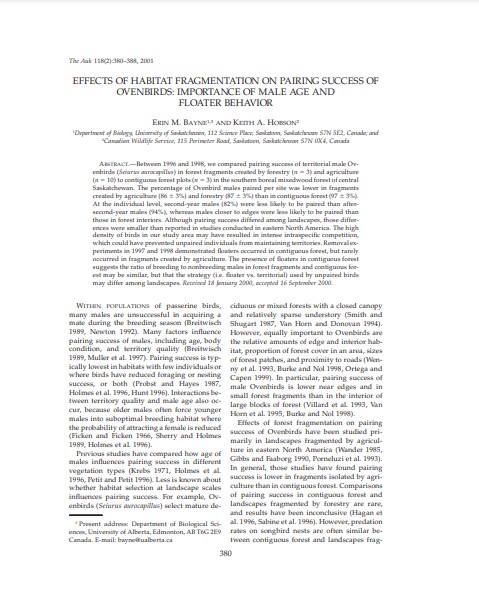Effects of habitat fragmentation on pairing success of ovenbirds: Importance of male age and floater behavior
Bosque Modelo:
Prince Albert
Temática:
Gestión forestal
Tipo de documento:
Artículo científico
Resumen
Between 1996 and 1998, we compared pairing success of territorial male Ovenbirds (Seiurus aurocapillus) in forest fragments created by forestry (n 5 3) and agriculture (n 5 10) to contiguous forest plots (n 5 3) in the southern boreal mixedwood forest of central Saskatchewan. The percentage of Ovenbird males paired per site was lower in fragments created by agriculture (86 6 3%) and forestry (87 6 3%) than in contiguous forest (97 6 3%). At the individual level, second-year males (82%) were less likely to be paired than aftersecond-year males (94%), whereas males closer to edges were less likely to be paired than those in forest interiors. Although pairing success differed among landscapes, those differences were smaller than reported in studies conducted in eastern North America. The high density of birds in our study area may have resulted in intense intraspecific competition, which could have prevented unpaired individuals from maintaining territories. Removal experiments in 1997 and 1998 demonstrated floaters occurred in contiguous forest, but rarely occurred in fragments created by agriculture. The presence of floaters in contiguous forest suggests the ratio of breeding to nonbreeding males in forest fragments and contiguous forest may be similar, but that the strategy (i.e. floater vs. territorial) used by unpaired birds may differ among landscapes
Información Bibliográfica
Autor:
Bayne, EM and KA Hobson.
Revista:
The Auk
Año:
2001
N°:
2
País :
Canadá
Páginas:
380 - 388
Volumen:
118
Idioma:
Ingles
Palabras claves
Impact, Model Forest





